All Exams >
Electrical Engineering (EE) >
Basic Electrical Technology >
All Questions
All questions of Introduction for Electrical Engineering (EE) Exam
Find the voltage across the 6 ohm resistor.

- a)150V
- b)181,6V
- c) 27.24V
- d)54.48V
Correct answer is option 'C'. Can you explain this answer?
Find the voltage across the 6 ohm resistor.

a)
150V
b)
181,6V
c)
27.24V
d)
54.48V

|
Cstoppers Instructors answered |
Total current = 150/(6+12+15) = 4.55A.
V across 6 ohm = Total current x resistance
= 4.55 * 6 = 27.24V.
Calculate the total current in the circuit. a)20A
a)20A
b)11.42A
c)12Ad)15ACorrect answer is option 'B'. Can you explain this answer?
|
|
Gargi Basak answered |
The 1 ohm and 2-ohm resistor are in series which is in parallel to the 3-ohm resistor.
The equivalent of these resistances is in series with the 4 ohms and 5-ohm resistor.
Total R= 10.5 ohm. I=V/R= 120/10.5= 11.42A.
The equivalent of these resistances is in series with the 4 ohms and 5-ohm resistor.
Total R= 10.5 ohm. I=V/R= 120/10.5= 11.42A.
Find the current in the circuit. a)1Ab)2Ac)3A... mored)4ACorrect answer is option 'B'. Can you explain this answer?
a)1Ab)2Ac)3A... mored)4ACorrect answer is option 'B'. Can you explain this answer?
|
|
Nandita Bajaj answered |
I = V/R.
Total resistance = 20+40 = 60ohm.
I = 120V.
I = 120/60 = 2A.
Voltage across the 60ohm resistor is______

- a)72V
- b)0V
- c) 48V
- d) 120V
Correct answer is option 'B'. Can you explain this answer?
Voltage across the 60ohm resistor is______

a)
72V
b)
0V
c)
48V
d)
120V
|
|
Bhavana Reddy answered |
The 60ohm resistance is shorted since current always choses the low resistance path. Voltage across short circuit is equal to zero, hence voltage across the resistor is 0.
Which of the following statements are true with regard to resistance?- a)Resistance is directly proportional to length of the wire
- b)Resistance is directly proportional to area of cross section of the wire
- c)Resistance is inversely proportional to the length of the wire
- d)All the statements are false
Correct answer is option 'B'. Can you explain this answer?
Which of the following statements are true with regard to resistance?
a)
Resistance is directly proportional to length of the wire
b)
Resistance is directly proportional to area of cross section of the wire
c)
Resistance is inversely proportional to the length of the wire
d)
All the statements are false
|
|
Avinash Mehta answered |
Correct answer is option a)
(1) As the length of the wire increases, the electrons in the wire have to travel more distance. During the journey, they collide with the atoms in the material of the wire. These collisions give rise to the resistance of the wire. As the number of collisions increase with increase in length, the resistance also increases. So, Resistance is directly proportional to length of the wire.
(2) The larger the cross-sectional area of the conductor, the more electrons are available to carry the current, so the lower the resistance. Therefore, resistance is inversely proportional to area of cross section of conductor.
Calculate the equivalent resistance between A and B.

- a) 60 ohm
- b) 15 ohm
- c)12 ohm
- d)48 ohm
Correct answer is option 'C'. Can you explain this answer?
Calculate the equivalent resistance between A and B.

a)
60 ohm
b)
15 ohm
c)
12 ohm
d)
48 ohm
|
|
Akanksha Chopra answered |
The 5 ohm and 15 ohm resistances are connected in series and 10 ohm and 20 ohm resistors are also connected in series. Therefore,20 ohm and 30 ohm are parallel with each other.
Can you explain the answer of this question below:... moreWhat is the value of x if the current in the circuit is 5A?
 A:15 ohmB:65 ohmC:55 ohmD:45 ohmThe answer is a.
A:15 ohmB:65 ohmC:55 ohmD:45 ohmThe answer is a.
|
|
Ishani Iyer answered |
Total voltage=sum of voltages across each resistor. =>150=10*5+5*5+5*x. Solving the equation, we get x=15 ohm.
The total resistance between A and B are?

- a)20 ohm
- b)5 ohm
- c)80 ohm
- d)0 ohm
Correct answer is option 'B'. Can you explain this answer?
The total resistance between A and B are?

a)
20 ohm
b)
5 ohm
c)
80 ohm
d)
0 ohm
|
|
Ameya Gupta answered |
The resistors are connected in parallel, hence the equivalent resistance= 1/(1/20=1/20+1/20+1/20)=5ohm.
Which of the following is not an expression power?- a)P=VI
- b)P=I2R
- c)P=V2/R
- d)All of the mentioned
Correct answer is option 'D'. Can you explain this answer?
Which of the following is not an expression power?
a)
P=VI
b)
P=I2R
c)
P=V2/R
d)
All of the mentioned
|
|
Prerna Tiwari answered |
Power is the product of voltage and current. Writing I in terms of V, we get P=V2/R and writing V in terms of I, we get P=I2r.
Calculate the equivalent resistance between A and B.

- a) 2 ohm
- b)4 ohm
- c)6 ohm
- d)8 ohm
Correct answer is option 'A'. Can you explain this answer?
Calculate the equivalent resistance between A and B.

a)
2 ohm
b)
4 ohm
c)
6 ohm
d)
8 ohm
|
|
Sharmila Kulkarni answered |
R=((2+3)||5)+1.5)||4.The 2 and the 3 ohm resistor are in series. The equiva-lent of these two resistors is in parallel with the 5 ohm resistor. The equivalent of these three resistances is in series with the 1.5 ohm resistor. Finally, the equivalent of these re-sistances is in parallel with the 4 ohm resistor.
Calculate the current across the 20 ohm resistor.
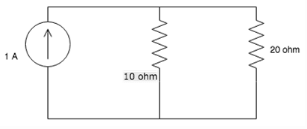
- a)20A
- b)1A
- c)0.67A
- d)0.33A
Correct answer is option 'D'. Can you explain this answer?
Calculate the current across the 20 ohm resistor.

a)
20A
b)
1A
c)
0.67A
d)
0.33A
|
|
Aashna Dey answered |
Using current divider rule the current through the 20 ohm resistor= (total current in the circuit x resistance of the other branch)/total resistance= 1×10/30=3.33A.
Find the value of the currents I1 and I2.
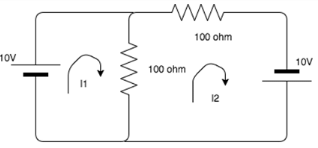
- a) 0.3, 0.1
- b) -0.1, -0.3
- c) 0.1, 0.2
- d)-0.3, -0.1
Correct answer is option 'C'. Can you explain this answer?
Find the value of the currents I1 and I2.

a)
0.3, 0.1
b)
-0.1, -0.3
c)
0.1, 0.2
d)
-0.3, -0.1
|
|
Neha Nambiar answered |
To explain: Using KVL in loop 1, 10-100 i1=0. i1=0.1A
Using KVL in outer loop, -100i2+20=0 i2=0.2A.
Correct Answer is d) 0.1, 0.2
KVL is applied in ____________- a)Mesh analysis
- b)Nodal analysis
- c)Both mesh and nodal
- d)Neither mesh nor nodal
Correct answer is option 'A'. Can you explain this answer?
KVL is applied in ____________
a)
Mesh analysis
b)
Nodal analysis
c)
Both mesh and nodal
d)
Neither mesh nor nodal
|
|
Ritika Mukherjee answered |
Explanation:
Mesh analysis helps us to utilize the different voltages in the circuit as well as the IR products in the circuit which is nothing but KVL.
You can know more about Kirchhoff's Laws through the document:
KCL deals with the conservation of?- a)Mass
- b)Momentum
- c)Charge
- d)Energy
Correct answer is option 'D'. Can you explain this answer?
KCL deals with the conservation of?
a)
Mass
b)
Momentum
c)
Charge
d)
Energy

|
Bijoy Kapoor answered |
Kirchhoff’s Current Law
Kirchhoff’s Current Law (KCL) is Kirchhoff’s first law that deals with the conservation of charge entering and leaving a junction. To determine the amount or magnitude of the electrical current flowing around an electrical or electronic circuit, we need to use certain laws or rules that allows us to write down these currents in the form of an equation. The network equations used are those according to Kirchhoff’s laws, and as we are dealing with circuit currents, we will be looking at Kirchhoff’s current law, (KCL).
If two bulbs are connected in parallel and one bulb blows out, what happens to the other bulb?- a)The other bulb blows out as well
- b)The other bulb continues to glow with the same brightness
- c)The other bulb glows with increased brightness
- d)The other bulb stops glowing
Correct answer is option 'B'. Can you explain this answer?
If two bulbs are connected in parallel and one bulb blows out, what happens to the other bulb?
a)
The other bulb blows out as well
b)
The other bulb continues to glow with the same brightness
c)
The other bulb glows with increased brightness
d)
The other bulb stops glowing
|
|
Sanchita Sharma answered |
In a parallel circuit, if one bulb blows out, it acts as an open circuit. Current does not flow in that branch but it continues to flow in the other branch hence the bulb continues to glow.
The voltage across the short is?

- a)135V
- b)Infinity
- c) Zero
- d)11.25V
Correct answer is option 'C'. Can you explain this answer?
The voltage across the short is?

a)
135V
b)
Infinity
c)
Zero
d)
11.25V
|
|
Sanvi Kapoor answered |
The voltage across a short is always equal to zero whether it is connected in seroes or parallel.
A 250V bulb passes a current of 0.3A. Calculate the power in the lamp.- a)75W
- b)50W
- c)25W
- d)90W
Correct answer is option 'A'. Can you explain this answer?
A 250V bulb passes a current of 0.3A. Calculate the power in the lamp.
a)
75W
b)
50W
c)
25W
d)
90W
|
|
Rajeev Menon answered |
Here, V = 250v and I = 0.3A. P=VI. Which implies that, P=250*0.3=75W.
Calculate the current across the 20 ohm resistor.

- a)10A
- b) 20A
- c) 36.67A
- d) 6.67A
Correct answer is option 'A'. Can you explain this answer?
Calculate the current across the 20 ohm resistor.

a)
10A
b)
20A
c)
36.67A
d)
6.67A
|
|
Sharmila Bajaj answered |
Explanation: I=V/R. Since in parallel circuit, voltage is same across all resistors. Hence across the 20 ohm resistor, V=200V so I=200/20=10A.
What is the unit of temperature coefficient?- a)ohm/centigrade
- b)ohm-centigrade
- c)centigrade-1
- d)centigrade
Correct answer is option 'C'. Can you explain this answer?
What is the unit of temperature coefficient?
a)
ohm/centigrade
b)
ohm-centigrade
c)
centigrade-1
d)
centigrade
|
|
Srestha Kumar answered |
: R=Reff[1+temp. coeff(T-Teff)].
From the given expression: (R/Reff-1)/(T-Teff)= temp. coeff. Hence, the unit is the reciprocal of that of temperature= centigrade-1.
From the given expression: (R/Reff-1)/(T-Teff)= temp. coeff. Hence, the unit is the reciprocal of that of temperature= centigrade-1.
Which of the following statements are true?- a)Power is proportional to Voltage
- b)Power is proportional to current
- c)Neither of the statements are right
- d)Both the statements are right
Correct answer is option 'D'. Can you explain this answer?
Which of the following statements are true?
a)
Power is proportional to Voltage
b)
Power is proportional to current
c)
Neither of the statements are right
d)
Both the statements are right
|
|
Sanskriti Kaur answered |
Power is proportional to both voltage and current. Hence both the options are right.
Calculate the current A.

- a) 5A
- b)10A
- c)15A
- d) 20A
Correct answer is option 'C'. Can you explain this answer?
Calculate the current A.

a)
5A
b)
10A
c)
15A
d)
20A
|
|
Anoushka Kumar answered |
KCl states that the total current leaving the junction is equal to the current entering it. In this case, the current entering the junction is 5A+10A=15A.
Batteries are generally connected in______- a)Series
- b)Parallel
- c)Either series or parallel
- d)Neither series nor parallel
Correct answer is option 'A'. Can you explain this answer?
Batteries are generally connected in______
a)
Series
b)
Parallel
c)
Either series or parallel
d)
Neither series nor parallel
|
|
Sakshi Roy answered |
Batteries are generally connected in series so that we can obtain the desired voltage since voltages add up once they are connected in series.
Every____________ is a ____________ but every __________ is not a __________- a)Mesh, loop, loop, mesh
- b)Loop, mesh, mesh, loop
- c)Loop, mesh, loop, mesh
- d)Mesh, loop, mesh, loop
Correct answer is option 'A'. Can you explain this answer?
Every____________ is a ____________ but every __________ is not a __________
a)
Mesh, loop, loop, mesh
b)
Loop, mesh, mesh, loop
c)
Loop, mesh, loop, mesh
d)
Mesh, loop, mesh, loop
|
|
Raj Desai answered |
According to Kirchhoff’s Voltage Law, Every mesh is a loop but every loop is not a mesh.
Find the value of v if v1=20V.
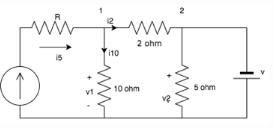
- a)10V
- b) 12V
- c)14V
- d)16V
Correct answer is option 'B'. Can you explain this answer?
Find the value of v if v1=20V.

a)
10V
b)
12V
c)
14V
d)
16V

|
Cstoppers Instructors answered |
The current through the 10 ohm resistor = v1 / 10 = 2A
Applying KCL at node 1: i5 = i10 + i2
i2 = 6 - 2 = 4A
Thus the drop in the 2 ohm resistor = 4×2 = 8V
v1 = 20V; hence v2 = 20-v across 2 ohm resistor = 20 - 8 = 12V
v2 = v since they are connected in parallel.
v = 12V
v2 = v since they are connected in parallel.
v = 12V
Calculate the value of V1 and V2.
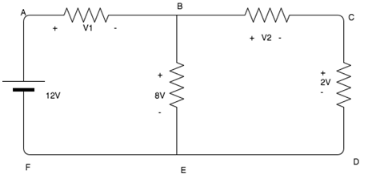
- a)4V, 6V
- b)5V, 6V
- c)6V, 7V
- d)7V, 8V
Correct answer is option 'A'. Can you explain this answer?
Calculate the value of V1 and V2.

a)
4V, 6V
b)
5V, 6V
c)
6V, 7V
d)
7V, 8V
|
|
Nishtha Chauhan answered |
Using KVL, 12-V1-8=0. V1= 4V.
8-V2-2=0. V2=6V.
8-V2-2=0. V2=6V.
In a series circuit, which of the parameters remain constant across all circuit elements such as resistor, capacitor and inductor etcetera?- a)Voltage
- b)Current
- c)Both voltage and current
- d)Neither voltage nor current
Correct answer is option 'B'. Can you explain this answer?
In a series circuit, which of the parameters remain constant across all circuit elements such as resistor, capacitor and inductor etcetera?
a)
Voltage
b)
Current
c)
Both voltage and current
d)
Neither voltage nor current

|
Swara Dasgupta answered |
In a series circuit, the current across all elements remain the same and the total voltage of the circuit is the sum of the voltages across all the elements.
Calculate the resistance between A and B.

- a)3.56 ohm
- b)7 ohm
- c)14.26 ohm
- d)29.69 ohm
Correct answer is option 'A'. Can you explain this answer?
Calculate the resistance between A and B.


a)
3.56 ohm
b)
7 ohm
c)
14.26 ohm
d)
29.69 ohm
|
|
Lavanya Menon answered |
- The 1 ohm, 2 ohm and 3 ohm resistors are connected in parallel. Its equivalent resistance is in series with the 4 ohm resistor and the parallel connection of the 5 ohm and 6 ohm resistor.
- The equivalent resistance of this combination is 80/11 ohm. This is in parallel with 7 ohm to give equivalent resistance between A and B is 3.56 ohm.
If there are two bulbs connected in series and one blows out, what happens to the other bulb?- a)The other bulb continues to glow with the same brightness
- b)The other bulb stops glowing
- c)The other bulb glows with increased brightness
- d)The other bulb also burns out
Correct answer is option 'B'. Can you explain this answer?
If there are two bulbs connected in series and one blows out, what happens to the other bulb?
a)
The other bulb continues to glow with the same brightness
b)
The other bulb stops glowing
c)
The other bulb glows with increased brightness
d)
The other bulb also burns out
|
|
Shivam Das answered |
Explanation:
When two bulbs are connected in series, they share the same current. This means that the current flowing through each bulb is the same.
When one of the bulbs blows out, the circuit is broken and the current can no longer flow through both bulbs. Instead, the current will flow through the path of least resistance, which in this case is the blown-out bulb.
Therefore, the other bulb will stop glowing because there is no longer any current flowing through it.
In summary, when one bulb in a series circuit blows out, the other bulb will stop glowing.
When two bulbs are connected in series, they share the same current. This means that the current flowing through each bulb is the same.
When one of the bulbs blows out, the circuit is broken and the current can no longer flow through both bulbs. Instead, the current will flow through the path of least resistance, which in this case is the blown-out bulb.
Therefore, the other bulb will stop glowing because there is no longer any current flowing through it.
In summary, when one bulb in a series circuit blows out, the other bulb will stop glowing.
What happens to the current in the series circuit if the resistance is doubled?- a)It becomes half its original value
- b)It becomes double its original value
- c)It becomes zero
- d)It becomes infinity
Correct answer is option 'A'. Can you explain this answer?
What happens to the current in the series circuit if the resistance is doubled?
a)
It becomes half its original value
b)
It becomes double its original value
c)
It becomes zero
d)
It becomes infinity
|
|
Rajesh Verma answered |
I=V/R. Hence if R=2R V=I/2R, and I=I/2.
The SI unit of power is?- a)kW(kilo-watt)
- b)J/s(joules per second)
- c)d)
- d)c) Ws(watt-second)d) J/h(joules per hour
Correct answer is option 'B'. Can you explain this answer?
The SI unit of power is?
a)
kW(kilo-watt)
b)
J/s(joules per second)
c)
d)
d)
c) Ws(watt-second)d) J/h(joules per hour
|
|
Nandita Bajaj answered |
Power = energy/time =J/s(joules per second). Hence the Si unit of Power is J/s.
What is the current through R1 and R2 in the following diagram?
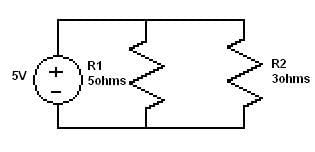
- a)I1 =1.875 I2 = 3.125.
- b)
 ,
,  .
.
- c)
 ,
, 
- d)
 ,
,  .
.
Correct answer is option 'A'. Can you explain this answer?
What is the current through R1 and R2 in the following diagram?

a)
I1 =1.875 I2 = 3.125.
b)
 ,
,  .
.c)
 ,
, 
d)
 ,
,  .
.|
|
Saumya Sen answered |
- All are In parallel so voltage is same
- I1 = ( R2/R1+R2 )V = ( 3/8 )x5A = 1.875
- I2 = ( R1/R1+R2 )V = ( 5/8 )x5A = 3.125
Calculate the voltage across the 10 ohm resistor.
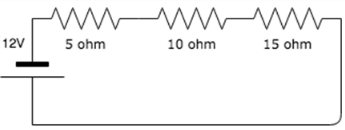
- a)12V
- b) 4V
- c)10V
- d)0V
Correct answer is option 'B'. Can you explain this answer?
Calculate the voltage across the 10 ohm resistor.

a)
12V
b)
4V
c)
10V
d)
0V
|
|
Ravi Singh answered |
Using voltage divider rule, V=10*12/30=4V.
Which of the following statements are true about insulators?- a)Insulators have a positive temperature coefficient
- b)Insulators have a negative temperature coefficient
- c)Insulators have zero temperature coefficient
- d)Insulators have infinite temperature coefficient
Correct answer is option 'B'. Can you explain this answer?
Which of the following statements are true about insulators?
a)
Insulators have a positive temperature coefficient
b)
Insulators have a negative temperature coefficient
c)
Insulators have zero temperature coefficient
d)
Insulators have infinite temperature coefficient
|
|
Ravi Singh answered |
Insulators have a negative temperature coefficient because as temperature increases, the resistance of insulators decreases.
In a parallel circuit, with a number of resistors, the voltage across each resistor is ________- a)The same for all resistors
- b)Is divided equally among all resistors
- c)Is divided proportionally across all resistors
- d)Is zero for all resistors
Correct answer is option 'A'. Can you explain this answer?
In a parallel circuit, with a number of resistors, the voltage across each resistor is ________
a)
The same for all resistors
b)
Is divided equally among all resistors
c)
Is divided proportionally across all resistors
d)
Is zero for all resistors
|
|
Jyoti Basak answered |
In parallel circuits, the current across the circuits vary whereas the voltage remains the same.
The temperature of a coil cannot be measured by which of the following methods?- a)Thermometer
- b)Increase in resistance of the coil
- c)Thermo-junctions embedded in the coil
- d)Caloriemeter
Correct answer is option 'D'. Can you explain this answer?
The temperature of a coil cannot be measured by which of the following methods?
a)
Thermometer
b)
Increase in resistance of the coil
c)
Thermo-junctions embedded in the coil
d)
Caloriemeter

|
Kaavya Sengupta answered |
In order to measure heats of reactions, we often enclose reactants in a calorimeter, initiate the reaction, and measure the temperature difference before and after the reaction. The temperature difference enables us to evaluate the heat released in the reaction.
What is the voltage measured across a series short?- a)Infinite
- b)Zero
- c)The value of the source voltage
- d)Null
Correct answer is option 'B'. Can you explain this answer?
What is the voltage measured across a series short?
a)
Infinite
b)
Zero
c)
The value of the source voltage
d)
Null
|
|
Om Saini answered |
A short is just a wire. The potential difference between two points of a wire is zero hence the voltage measured is equal to zero.
A wire of length 2m and another wire of length 5m are made up of the same material and have the same area of cross section, which wire has higher resistance?- a)Both have equal resistance
- b)The 2m wire has higher resistance
- c)The 5m wire has higher resistance
- d)The value of resistance cannot be determined from the given data
Correct answer is option 'C'. Can you explain this answer?
A wire of length 2m and another wire of length 5m are made up of the same material and have the same area of cross section, which wire has higher resistance?
a)
Both have equal resistance
b)
The 2m wire has higher resistance
c)
The 5m wire has higher resistance
d)
The value of resistance cannot be determined from the given data

|
Sagarika Patel answered |
Resistance is directly proportional to the length of the wire, hence as the length of the wire increases, resistance increases.
Calculate the work done in a resistor of 20 ohm carrying 5A of current in 3 hours.- a)1.5J
- b)15J
- c)1.5kWh
- d)15kWh
Correct answer is option 'C'. Can you explain this answer?
Calculate the work done in a resistor of 20 ohm carrying 5A of current in 3 hours.
a)
1.5J
b)
15J
c)
1.5kWh
d)
15kWh
|
|
Ravi Singh answered |
To find power: P=I2R=52*20=500W=0.5kW.
To find Work done: W=Pt=0.5*3=1.5kWh.
To find Work done: W=Pt=0.5*3=1.5kWh.
The resistance of insulators __________- a)Increases with increase in temperature
- b)Decreases with increase in temperature
- c)Remains the same with increase in temperature
- d)Becomes zero with increase in temperature
Correct answer is option 'B'. Can you explain this answer?
The resistance of insulators __________
a)
Increases with increase in temperature
b)
Decreases with increase in temperature
c)
Remains the same with increase in temperature
d)
Becomes zero with increase in temperature
|
|
Gayatri Menon answered |
In case of an insulator, the energy gap between the conduction band and the valence band is very large. When the temperature is increased, the electrons move from the conduction band to the valence band and hence it starts conducting. When conductance increases, resistance decreases, since C=1/R. Thus, when temperature increases, resistance decreases in insulators.
Voltage across a series resistor circuit is proportional to?- a)The amount of time the circuit was on for
- b)The value of the resistance itself
- c)The value of the other resistances in the circuit
- d)The power in the circuit
Correct answer is option 'B'. Can you explain this answer?
Voltage across a series resistor circuit is proportional to?
a)
The amount of time the circuit was on for
b)
The value of the resistance itself
c)
The value of the other resistances in the circuit
d)
The power in the circuit

|
Shivam Sharma answered |
V=IR hence voltage across a series resistor circuit is proportional to the value of the resistance.
KCL is applied at _________- a)Loop
- b)Node
- c)Both loop and node
- d)Neither loop nor node
Correct answer is option 'B'. Can you explain this answer?
KCL is applied at _________
a)
Loop
b)
Node
c)
Both loop and node
d)
Neither loop nor node
|
|
Sanskriti Bajaj answered |
KCL states that the amount of charge leaving a node is equal to the amount of charge entering it, hence it is applied at nodes.
Materials having resistance almost equal to zero is_______- a)Semi-conductor
- b)Conductor
- c)Superconductors
- d)Insulators
Correct answer is option 'C'. Can you explain this answer?
Materials having resistance almost equal to zero is_______
a)
Semi-conductor
b)
Conductor
c)
Superconductors
d)
Insulators

|
Baishali Bajaj answered |
In a superconductor, the electric resistance is equal to zero. This is why an electric current can circulate forever in a superconducting ring even when the battery has been unplugged! This is how magnetic fields are created in MRIs. It might seem odd that a battery could create a low voltage electric current at the terminals of a superconducting network, since the voltage should be equal to zero because of the absence of electric resistance. What happens is that the electric tension created by the battery is divided into the other parts of the network, i.e. the metallic wires that link the battery to the superconductor and to the interior of the battery (internal resistance).
Practically, if 10kJ of energy is supplied to a device, how much energy will the device give back?- a)Equal to10kJ
- b)Less than 10kJ
- c)More than 10kJ
- d)Zero
Correct answer is option 'B'. Can you explain this answer?
Practically, if 10kJ of energy is supplied to a device, how much energy will the device give back?
a)
Equal to10kJ
b)
Less than 10kJ
c)
More than 10kJ
d)
Zero
|
|
Jatin Mukherjee answered |
Practically, if 10kJ of energy is supplied to a system, it returns less than the supplied energy because, some of the energy is lost as heat energy, sound energy etc.
Materials which allow the passage of electric current are known as______- a)Insulators
- b)Conductors
- c)Dielectrics
- d)Semi-conductors
Correct answer is option 'B'. Can you explain this answer?
Materials which allow the passage of electric current are known as______
a)
Insulators
b)
Conductors
c)
Dielectrics
d)
Semi-conductors
|
|
Mayank Sengupta answered |
Conductors are materials(mostly metals), which freely allow the passage of electrons through it. If electrons can flow freely through a material, it implies that even current can flow freely through that material since current is the rate of flow of electrons.
KCL can be applied for __________- a)Planar networks
- b)Non-planar networks
- c)Both planar and non-planar
- d)Neither planar nor non-planar
Correct answer is option 'C'. Can you explain this answer?
KCL can be applied for __________
a)
Planar networks
b)
Non-planar networks
c)
Both planar and non-planar
d)
Neither planar nor non-planar
|
|
Mihir Chawla answered |
KCL is applied for different nodes of a network whether it is planar or non-planar.
Many resistors connected in series will?- a)Divide the voltage proportionally among all the resistors
- b)Divide the current proportionally
- c)Increase the source voltage in proportion to the values of the resistors
- d)Reduce the power to zero
Correct answer is option 'A'. Can you explain this answer?
Many resistors connected in series will?
a)
Divide the voltage proportionally among all the resistors
b)
Divide the current proportionally
c)
Increase the source voltage in proportion to the values of the resistors
d)
Reduce the power to zero
|
|
Mansi Datta answered |
In a series circuit, the current remains the same across all resistors hence the voltage divides proportionally among all resistors.
A copper coil has a resistance of 200 ohm when its mean temperature is 0 degree centigrade. Calculate the resistance of the coil when its mean temperature is 80 degree centigrade.- a)268.5 ohm
- b)268.5 kilo-ohm
- c)286.5 ohm
- d)286.5 kilo-ohm
Correct answer is option 'A'. Can you explain this answer?
A copper coil has a resistance of 200 ohm when its mean temperature is 0 degree centigrade. Calculate the resistance of the coil when its mean temperature is 80 degree centigrade.
a)
268.5 ohm
b)
268.5 kilo-ohm
c)
286.5 ohm
d)
286.5 kilo-ohm
|
|
Harshitha Pillai answered |
The temperature coefficient of copper is 0.00428 centigrade-1
R1=R0(1+temp. coeff.*T1)= 200(1+0.00428*80)= 268.5 ohm.
R1=R0(1+temp. coeff.*T1)= 200(1+0.00428*80)= 268.5 ohm.
A circuit has a resistor with a resistance of 3Ω followed by three parallel branches, each holding a resistor with a resistance of 5Ω. What is the total equivalent resistance of the circuit?- a)15/3 Ω
- b)14/3 Ω
- c)15/7 Ω
- d)19/3 Ω
Correct answer is option 'B'. Can you explain this answer?
A circuit has a resistor with a resistance of 3Ω followed by three parallel branches, each holding a resistor with a resistance of 5Ω. What is the total equivalent resistance of the circuit?
a)
15/3 Ω
b)
14/3 Ω
c)
15/7 Ω
d)
19/3 Ω
|
|
Lavanya Menon answered |

What is the resistivity of Copper?- a)1.59*10-8ohm-m
- b) 2.7*10-8ohm-m
- c)7.3*10-8ohm-m
- d) 5.35*10-8ohm-m
Correct answer is option 'A'. Can you explain this answer?
What is the resistivity of Copper?
a)
1.59*10-8ohm-m
b)
2.7*10-8ohm-m
c)
7.3*10-8ohm-m
d)
5.35*10-8ohm-m
|
|
Mansi Choudhury answered |
Resistivity is a material property. Different materials have different resistivity’s. Resistivity depends on the material of the wire, hence the resistivity of copper is 1.59*10-8ohm-metre.
Calculate the energy dissipated by the circuit in 50 seconds.
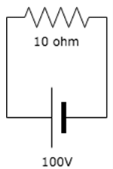
- a)50kJ
- b) 50J
- c) 100j
- d)100kJ
Correct answer is option 'A'. Can you explain this answer?
Calculate the energy dissipated by the circuit in 50 seconds.

a)
50kJ
b)
50J
c)
100j
d)
100kJ
|
|
Mansi Choudhury answered |
Here V = 100 and R = 10. Power in the circuit= V2/R= 1002/10= 1000W.
Energy= Pt= 1000*50= 50000J= 50kJ.
Energy= Pt= 1000*50= 50000J= 50kJ.
Chapter doubts & questions for Introduction - Basic Electrical Technology 2025 is part of Electrical Engineering (EE) exam preparation. The chapters have been prepared according to the Electrical Engineering (EE) exam syllabus. The Chapter doubts & questions, notes, tests & MCQs are made for Electrical Engineering (EE) 2025 Exam. Find important definitions, questions, notes, meanings, examples, exercises, MCQs and online tests here.
Chapter doubts & questions of Introduction - Basic Electrical Technology in English & Hindi are available as part of Electrical Engineering (EE) exam.
Download more important topics, notes, lectures and mock test series for Electrical Engineering (EE) Exam by signing up for free.
Basic Electrical Technology
74 docs|62 tests
|

Contact Support
Our team is online on weekdays between 10 AM - 7 PM
Typical reply within 3 hours
|
Free Exam Preparation
at your Fingertips!
Access Free Study Material - Test Series, Structured Courses, Free Videos & Study Notes and Prepare for Your Exam With Ease

 Join the 10M+ students on EduRev
Join the 10M+ students on EduRev
|

|
Create your account for free
OR
Forgot Password
OR
Signup to see your scores
go up within 7 days!
Access 1000+ FREE Docs, Videos and Tests
Takes less than 10 seconds to signup










